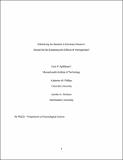| dc.contributor.author | Apfelbaum, Evan Paul | |
| dc.contributor.author | Phillips, Katherine W. | |
| dc.contributor.author | Richeson, Jennifer A. | |
| dc.date.accessioned | 2014-06-11T14:38:05Z | |
| dc.date.available | 2014-06-11T14:38:05Z | |
| dc.date.issued | 2014-05 | |
| dc.identifier.issn | 1745-6916 | |
| dc.identifier.issn | 1745-6924 | |
| dc.identifier.uri | http://hdl.handle.net/1721.1/87730 | |
| dc.description.abstract | It is often surprisingly difficult to make definitive scientific statements about the functional value of group diversity. We suggest that one clear pattern in the group diversity literature is the prevailing convention of interpreting outcomes as the effect of diversity alone. Although work in this arena typically compares diverse groups with homogeneous ones, we most often conceive of homogeneous groups as a baseline—a reference point from which we can understand how diversity has changed behavior or what type of response is “normal.” In this article, we offer a new perspective through a focus on two propositions. The first proposition is that homogeneity has independent effects of its own—effects that, in some cases, are robust in comparison with the effects of diversity. The second proposition is that even though subjective responses in homogeneous groups are often treated as a neutral indicator of how people would ideally respond in a group setting, evidence suggests that these responses are often less objective or accurate than responses in diverse groups. Overall, we believe that diversity research may unwittingly reveal important insights regarding the effects of homogeneity. | en_US |
| dc.description.sponsorship | National Science Foundation (U.S.) (NSF Grant 0921728) | en_US |
| dc.language.iso | en_US | |
| dc.publisher | Sage Publications | en_US |
| dc.relation.isversionof | http://dx.doi.org/10.1177/1745691614527466 | en_US |
| dc.rights | Creative Commons Attribution-Noncommercial-Share Alike | en_US |
| dc.rights.uri | http://creativecommons.org/licenses/by-nc-sa/4.0/ | en_US |
| dc.source | Apfelbaum | en_US |
| dc.title | Rethinking the Baseline in Diversity Research: Should We Be Explaining the Effects of Homogeneity? | en_US |
| dc.type | Article | en_US |
| dc.identifier.citation | Apfelbaum, E. P., K. W. Phillips, and J. A. Richeson. “Rethinking the Baseline in Diversity Research: Should We Be Explaining the Effects of Homogeneity?” Perspectives on Psychological Science 9, no. 3 (May 1, 2014): 235–244. | en_US |
| dc.contributor.department | Sloan School of Management | en_US |
| dc.contributor.approver | Apfelbaum, Evan Paul | en_US |
| dc.contributor.mitauthor | Apfelbaum, Evan Paul | en_US |
| dc.relation.journal | Perspectives on Psychological Science | en_US |
| dc.eprint.version | Author's final manuscript | en_US |
| dc.type.uri | http://purl.org/eprint/type/JournalArticle | en_US |
| eprint.status | http://purl.org/eprint/status/PeerReviewed | en_US |
| dspace.orderedauthors | Apfelbaum, E. P.; Phillips, K. W.; Richeson, J. A. | en_US |
| dc.identifier.orcid | https://orcid.org/0000-0002-1941-4700 | |
| mit.license | OPEN_ACCESS_POLICY | en_US |
| mit.metadata.status | Complete | |
